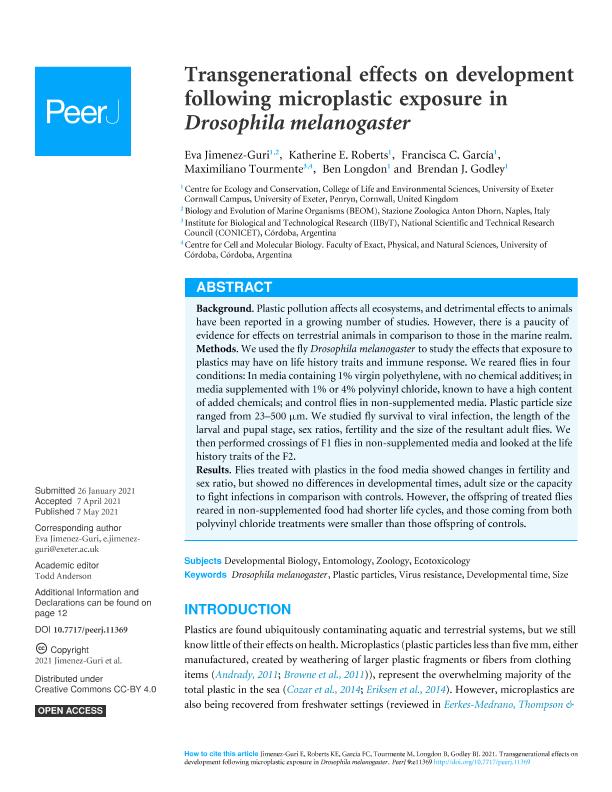Artículo
Transgenerational effects on development following microplastic exposure in Drosophila melanogaster
Jimenez-Guri, Eva; Roberts, Katherine E.; García, Francisca C.; Tourmente, Maximiliano ; Longdon, Ben; Godley, Brendan J.
; Longdon, Ben; Godley, Brendan J.
 ; Longdon, Ben; Godley, Brendan J.
; Longdon, Ben; Godley, Brendan J.
Fecha de publicación:
07/05/2021
Editorial:
PeerJ Inc.
Revista:
PeerJ
e-ISSN:
2167-8359
Idioma:
Inglés
Tipo de recurso:
Artículo publicado
Clasificación temática:
Resumen
Background. Plastic pollution affects all ecosystems, and detrimental effects to animals have been reported in a growing number of studies. However, there is a paucity of evidence for effects on terrestrial animals in comparison to those in the marine realm. Methods. We used the fly Drosophila melanogaster to study the effects that exposure to plastics may have on life history traits and immune response. We reared flies in four conditions: In media containing 1% virgin polyethylene, with no chemical additives; in media supplemented with 1% or 4% polyvinyl chloride, known to have a high content of added chemicals; and control flies in non-supplemented media. Plastic particle size ranged from 23–500 µm. We studied fly survival to viral infection, the length of the larval and pupal stage, sex ratios, fertility and the size of the resultant adult flies. We then performed crossings of F1 flies in non-supplemented media and looked at the life history traits of the F2. Results. Flies treated with plastics in the food media showed changes in fertility and sex ratio, but showed no differences in developmental times, adult size or the capacity to fight infections in comparison with controls. However, the offspring of treated flies reared in non-supplemented food had shorter life cycles, and those coming from both polyvinyl chloride treatments were smaller than those offspring of controls.
Archivos asociados
Licencia
Identificadores
Colecciones
Articulos(IIBYT)
Articulos de INSTITUTO DE INVESTIGACIONES BIOLOGICAS Y TECNOLOGICAS
Articulos de INSTITUTO DE INVESTIGACIONES BIOLOGICAS Y TECNOLOGICAS
Citación
Jimenez-Guri, Eva; Roberts, Katherine E.; García, Francisca C.; Tourmente, Maximiliano; Longdon, Ben; et al.; Transgenerational effects on development following microplastic exposure in Drosophila melanogaster; PeerJ Inc.; PeerJ; 9; 7-5-2021; 1-18; e11369
Compartir
Altmétricas



